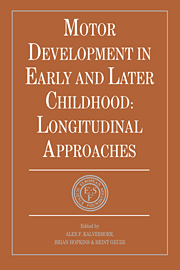Book contents
- Frontmatter
- Contents
- List of contributors
- Foreword
- Preface
- SETTING THE SCENE
- SECTION I BIOLOGICAL BASIS OF MOTOR DEVELOPMENT
- SECTION II DEVELOPMENT OF BODY POSTURE AND GOAL-DIRECTED REACHING
- SECTION III MOTOR DEVELOPMENT, EARLY COMMUNICATION AND COGNITION
- SECTION IV ACQUISITION OF SKILLS
- SECTION V MOTOR DEVELOPMENT AND HANDICAP
- 16 Early motor development in term and preterm children
- 17 Relationship between perinatal risk factors and motor development at the ages of 5 and 9 years
- 18 Motor development and minor handicap
- 19 Longitudinal and cross-sectional approaches in experimental studies in motor development
- SECTION VI METHODOLOGICAL AND CONCEPTUAL CONSIDERATIONS
- Epilogue: description versus explanation
- Index
18 - Motor development and minor handicap
from SECTION V - MOTOR DEVELOPMENT AND HANDICAP
Published online by Cambridge University Press: 05 May 2010
- Frontmatter
- Contents
- List of contributors
- Foreword
- Preface
- SETTING THE SCENE
- SECTION I BIOLOGICAL BASIS OF MOTOR DEVELOPMENT
- SECTION II DEVELOPMENT OF BODY POSTURE AND GOAL-DIRECTED REACHING
- SECTION III MOTOR DEVELOPMENT, EARLY COMMUNICATION AND COGNITION
- SECTION IV ACQUISITION OF SKILLS
- SECTION V MOTOR DEVELOPMENT AND HANDICAP
- 16 Early motor development in term and preterm children
- 17 Relationship between perinatal risk factors and motor development at the ages of 5 and 9 years
- 18 Motor development and minor handicap
- 19 Longitudinal and cross-sectional approaches in experimental studies in motor development
- SECTION VI METHODOLOGICAL AND CONCEPTUAL CONSIDERATIONS
- Epilogue: description versus explanation
- Index
Summary
There has been so much debate (e.g. Gubbay, 1975; Denckla, 1984; Henderson, 1986b) about how we might define or delineate minor motor handicap, ‘clumsiness’, developmental dyspraxia, minimal cerebral palsy, minimal cerebral dysfunction, etc. that I do not intend to add to it. Instead, I shall hide behind the cloak of officialdom and adopt the definition of this ‘condition’ provided by the American Psychiatric Association in the Diagnostic and statistical manual of mental disorders (APA, 1987). The condition is labelled ‘Developmental Coordination Disorder’ – an attractively neutral phrase – and is described as a marked impairment in the development of motor coordination that is not explicable by mental retardation and that is not due to a known physical disorder.
Over the last 20 years, there has been a huge increase in the number of longitudinal studies which have yielded data on the early development of children with mild to moderate motor impairment. They range from small-scale studies of children known to be at risk of later motor handicap (e.g. very low birth weight infants) to large-scale studies of unselected babies born at a particular point in time. To date, the majority of these studies concentrate on the period from birth to age 7 years. Rather few extend into the teenage years. As some of the studies describing motor development in the early years are dealt with in this volume, in the interest of variety, the first part of this chapter is devoted to investigations which follow the progress of their subjects beyond the age of 12 years.
- Type
- Chapter
- Information
- Motor Development in Early and Later ChildhoodLongitudinal Approaches, pp. 286 - 306Publisher: Cambridge University PressPrint publication year: 1993
- 21
- Cited by



